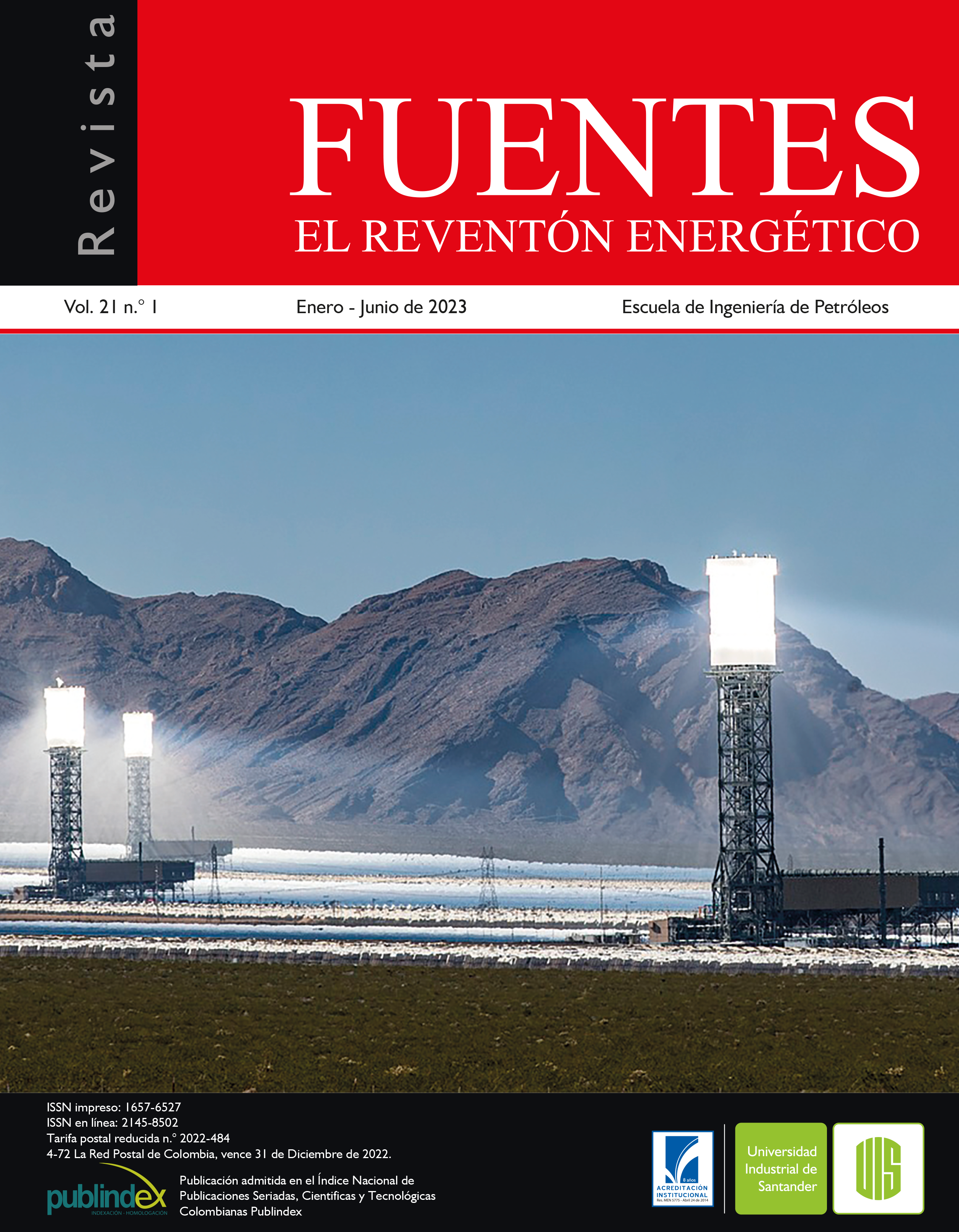COMPUTER AIDED EVALUATION OF SOLVENT EXTRACTION FOR LIGHT HYDROCARBON USING CARBON DIOXIDE
Published 2023-04-20
Keywords
- Computer Aided-Design,
- extraction,
- hydrocarbon,
- carbon dioxide,
- simulation
- process ...More
How to Cite

This work is licensed under a Creative Commons Attribution 4.0 International License.
Abstract
Different process of separation was used in the chemical industry, in particular, extraction is a process used to increase the quality of resins in oil removing impurities like organics solids and heavy metals. Supercritical carbon dioxide offers high selectivity at the end of the extraction process of light hydrocarbons from heavy oils mixture. A simulation technique in Aspen Plus ®software was used to develop the process and sensitivity analysis of the extraction configuration. The simulation of extraction process includes two output streams: the first one, a top stream (unpaved oil), and the second one a bottom stream (asphalt residue). A steady state methodology was implemented for process simulation. The sensitivity analysis was used to assess the influence of variables such as solvent flow rate, temperature and pressure. It was found a significant increase in the flow rate of unpaved oil when the solvent flow rate is increased. Optimal extraction values were selected depending on temperature and pressure effects over the process. An increase in temperature directly enhances the quality of API gravity. In certain occasions, an increase in pressure affects the light oils extraction because of product drag.
Downloads
References
- Abdulredha, M.M., Hussain, S.A., & Abdullah, L.C. (2020). Overview on petroleum emulsions, formation, influence and demulsification treatment techniques. Arabian Journal of Chemistry, 13 (1), 3403-3428. https://www.sciencedirect.com/science/article/pii/S1878535218302442
- Ahn, S., Shin, S., Im, S.I., Lee, K.B., & Nho, N.S. (2016). Solvent recovery in solvent deasphalting process for economical vacuum residue upgrading. Korean Journal of Chemical Engineering, 33(1), 265–270. https://link.springer.com/article/10.1007/s11814-015-0146-3
- Budisa N., & Schulze-Makuch, D. (2014). Supercritical Carbon Dioxide and Its Potential as a Life-Sustaining Solvent in a Planetary Environment. Life, 4(3), 331–340. https://www.mdpi.com/2075-1729/4/3/331
- Cárdenas, V.O.C. (2010). Estudo experimental e modelagem matemática da separação de asfaltenos e óleos lubrificantes provenientes do resíduo de petróleo por desasfaltação supercrítica. Universidade Estadual de Campinas. https://repositorio.unicamp.br/acervo/detalhe/782233
- De Souza R. A., De Oliveira A. A., Vieira Y. M., Zaparoli A. T., Wolf Maciel, M. R., Filho R. M., & Cárdenas-Concha, V. O. (2017). Sensibility analysis of propane deasphalting process variables. Petroleum Science and Technology, 35(1), 22–29. https://www.tandfonline.com/doi/abs/10.1080/10916466.2016.1225086?journalCode=lpet20
- Eckermann B., & Vogelpohl, A. (1990). Deasphaltization and demetalling of heavy crude oils and distillation residues with CO2. Chemical Engineering & Technology, 13(1), 258–264. https://onlinelibrary.wiley.com/doi/abs/10.1002/ceat.270130135
- Espinoza, S.N. (2001). Procesamiento supercrítico de productos naturales. Modelado, análisis y optimización. Universidad Nacional del Sur. http://repositoriodigital.uns.edu.ar/handle/123456789/2181
- Freitas A., Santana C., Silva R., & Silva, G. (2007). Investigação das facilidades e métodos utilizados atualmente no processamento primário de petróleo em campos onshore e offshore. 4o PDPETRO, 1–8. http://www.portalabpg.org.br/PDPetro/4/resumos/4PDPETRO_2_3_0322-1.pdf
- Grziwa. (1982). The chemistry and technology of petroleum: by James G. Speight Marcel Dekker, New York, Fuel Processing Technology, 5(3–4), 325–326. https://www.sciencedirect.com/science/article/pii/0378382082900261
- Holderbaum T., & Gmehling J. (1991). PSRK: Eine Zustandsgleichung zur Vorhersage von Dampf/ Flüssig‐Gleichgewichten bei mittleren und hohen Drücken. Chemie Ingenieur Technik, 63(1), 57–59.
- Hosseinifar, P., Shahverdi, H. (2021). A predictive method for constructing the distillation curve of petroleum fluids using their physical bulk properties. Journal of Petroleum Science and Engineering, 200, 108403. https://doi.org/10.1016/j.petrol.2021.108403
- Leal-Navarro, J., Mestre-Escudero, R., Puerta-Arana, A., León-Pulido, J., & González-Delgado, Á. D. (2019). Evaluating the Exergetic Performance of the Amine Treatment Unit in a Latin-American Refinery. ACS Omega, 4(26), 21993 –21997. https://pubs.acs.org/doi/10.1021/acsomega.9b03051
- Li, J., Fischer, K., & Gmehling, J. (1998). Prediction of vapor–liquid equilibria for asymmetric systems at low and high pressures with the PSRK model. Fluid Phase Equilibria, 143(1–2), 71–82. https://www.sciencedirect.com/science/article/abs/pii/S0378381298002064
- Liu, Z.M., Yang, G.Y., Lu, Y., Han, B.X., & Yan, H.K. (1999). Phase equilibria of the CO2–Jiangsu crude oil system and precipitation of heavy components induced by supercritical CO2. The Journal of Supercritical Fluids, 16 (1), 27-31. https://www.sciencedirect.com/science/article/abs/pii/S0896844699000182
- Martins S., Azevedo M., Silva M., & Silva, V. (2015). Produção de petróleo e impactos ambientais: algumas considerações. HOLOS, 6, 54-76. https://www2.ifrn.edu.br/ojs/index.php/HOLOS/article/view/2201/1212
- Mathias, P.M., & Copeman, T.W. (1983). Extension of the Peng-Robinson equation of state to complex mixtures: Evaluation of the various forms of the local composition concept. Fluid Phase Equilibria, 13, 91-108. https://www.sciencedirect.com/science/article/abs/pii/0378381283800843
- Peng, H., Yang, J., Peng, J., Han, H., Gou, X., Jia, Y., Li, Y., & Kadet, V. (2022). Influence of supercritical CO2 on the physical property of tight sandstone. Petroleum. https://www.sciencedirect.com/science/article/pii/S2405656122000645
- Pulido, J.L., Martinez Arias, E.L., Wolf Maciel, M.R., & Maciel Filho, R. (2011). Heat Integrated Reactive Distillation Column (r-HIDiC): Implementing a New Technology Distillation. Chemical Engineering Transactions, 24, 1303- 1308. https://www.cetjournal.it/index.php/cet/article/view/CET1124218
- Riazi, M.R. (2005). Characterization and properties of petroleum fractions. ASTM International. https://www.astm.org/mnl50-eb.html
- Rincón, F.D. (2009). Representação do petróleo através de componentes reais para a simulação de processos de refino. Universidade de São Paulo. http://www.teses.usp.br/teses/disponiveis/3/3137/tde-18082009-142836/es.php
- Rudyk, S., Spirov, P., Al-Hajri, R., & Vakili Nezhaad, G. (2017). Supercritical carbon dioxide extraction of oil sand enhanced by water and alcohols as Co-solvents. Journal of CO2 Utilization, 17, 90–98. https://www.sciencedirect.com/science/article/abs/pii/S2212982016304449
- Wilson, R.E., Keith Jr, P.C., & Haylett R.E. (1936). Liquid propane: Use in Dewaxing, Deasphalting, and Refining Heavy Oils. Industrial and Engineering Chemistry, 28(9), 1065–1078. https://pubs.acs.org/doi/10.1021/ie50321a022
- Yuan, Q., Zhang, Y., Wang, T., & Wang, J. (2023). Characterization of heavy metals in fly ash stabilized by carbonation with supercritical CO2 coupling mechanical force. Journal of CO2 Utilization, 67, 102308. https://doi.org/10.1016/j.jcou.2022.102308
